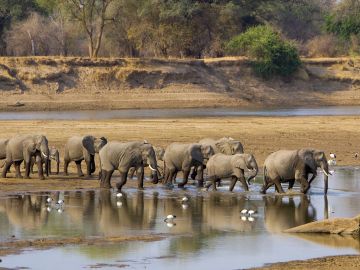Amazing places, scenery, people and activities

Zambia Safari Holidays
Our Zambia Safaris
Top 5 Wild Animals to Spot on a Zambia Safari
African Elephant: This majestic animal is the largest that you’ll see on Zambia safari holidays and is often spotted drinking from the waters of the Zambezi River. Although this huge beast can weight up to seven tonnes, it has an elegance that makes it one of the favourites of the Big Five. The Zambezi River is the fourth longest in Africa, flowing for 2,200 miles before reaching the Indian Ocean so it’s no surprise it’s one of the best places to see the African elephant. The best months to see them at the Zambezi is during the dry season between July and October when they come down to river to drink.
African Lion: When you think about Zambia safari tours, they most likely conjure up images of the African lion. Arguably the most awesome wild species on the continent, this big cat is revered yet feared at the same time. Lions are extremely social creatures within their prides and it’s not unusual for the lionesses to stay with the same pride for their entire lives. These fascinating beasts are often seen playing in Lower Zambezi National Park until the temperatures begin to soar and then they tend to sleep in the shade. Dusk is one of the best times to observe the lions as they set off on their evening hunt for prey.
Leopard: Renowned for being the most elusive of Africa’s Big Five, the leopard can lead you on a wild chase when trying to catch sight of it. They tend to hunt alone, hiding in the forest or deserts. The leopard mainly feasts on larger prey such as antelope and deer and are feared by many of the wild animals you’ll find in Zambia. While it is an intimidating species and one with incredible power, it also exudes an air of grace that is captivating to watch. The leopard is classed as a big cat but it’s the smallest compared to the lion, tiger, jaguar and cheetah and is extremely agile with an amazing talent for climbing trees.
Rhino: The rhino is often considered as a lolloping animal because of its size and sturdy build yet surprisingly it can run at speeds of up to 30-40mph. Imagine listening to the thunderous sound as herds of these hefty creatures speed across the wilderness. The average rhino can weigh up to almost 8,000 pounds with their horns protruding up to 5ft, making it one of the largest of the animals found in Africa. Downstream from the famous Victoria Falls, the rare white rhino can be seen along the banks of the Zambezi River.
Hippo: Cruising along the Zambezi River as if they haven’t a care in the world, the hippo is a water-loving ‘river horse’ that is often seen on trips to Zambia. While their pace is slow and they don’t particularly look terrifying, they are one of the most dangerous species in Africa. That said, they are still magnificent creatures to watch with fascinating personalities. At any one time you might see a huge herd of more than 60 hippos swimming along the river.
Sharon Livermore Discover Sri Lanka
Ruth Webster Discover Costa RicaExcellent introduction to a lovely country
Kurt Mills Discover Costa RicaThis was a jam-packed itinerary, with many walks and other activities, combined with a lot of driving. We moved on every two days, which was necessary to see everything, but it also meant there was no down time. Although this was a wildlife trip, at times the wildlife was rather shy. Some walks we saw very little. We probably saw more wildlife on the boat trips. Our expectations were probably not realistic, but we expected toucans and sloths to be hanging off every branch. It’s not like that (at least in the dry season). We didn’t see a sloth until halfway through the trip when there was one on a tree next to our hotel. Never saw a yellow-billed toucan, although we did see other toucans and toucanets (never knew there was such a thing!). Final count was around 150 different birds, as well as many other creatures (many of which we didn’t know existed). So the wildlife was amazing, but you need to know it doesn’t necessarily just pop out at you. On some walks, especially in Manuel Antonio, there were so many other groups looking at the same thing that it was quite difficult to get in to see things and was quite tiring at times. The walks throughout the trip were also very slow and we understand the pace was to suit looking for wildlife but walking so slowly was difficult and tiring in the heat.
The Adventure Begins Here
Get regular inspiration straight to your inbox from Exodus' experts.
